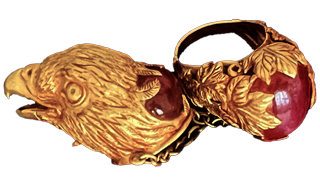Golden Jewelry Found with OKM Evolution in the Near East

Detected with
OKM Evolution (2010-2017)
Depth: 1.8 m (5.7 ft)
Region: Iran
We are deeply grateful for the permission to share this extraordinary discovery and extend our heartfelt congratulations to the treasure hunter. Out of respect for the burial site, located within an ancient cemetery, no photographs of the location were taken. Instead, the discoverer provided detailed scan images created with the detection software Visualizer 3D as well as photos of the magnificent piece of jewelry uncovered within the stone sarcophagus.
No one can tell this story better than the treasure hunter himself. Therefore, we allow him to recount his breathtaking discovery in his own words.
Hobby Treasure Hunter Unearths Ancient Jewelry
"I have been treasure hunting as a hobby for over a year, and this is my first find that truly left me speechless.
I knew the area was an ancient pre-Islamic cemetery. The graves were not long and none were aligned toward Qibla as Islamic graves are. Knowing that ancient civilizations often buried their dead with beautiful artifacts, I began scanning the site."


"When the scan revealed a positive signal, I rescanned the area with tighter and more precise vertical scan lines. It clearly confirmed a metal object beneath the surface."
"After two nights of digging, I reached a depth of 150 centimeters, or 4.9 feet. The clay turned into a sand-like material, and beneath it appeared a stone unlike anything else in the area."
"After clearing away the soil around it, the object revealed itself as a white rectangular cover, roughly 160 centimeters long. It was the lid of a stone sarcophagus. I lifted the heavy cover..."
What lies inside the sarcophagus?
"Inside, I saw fragments of human bones, black sand that felt oily, and a strong odor rose from within.
As I continued digging, several clay pots appeared. Each one held the same sandy material that crumbled into dust at the slightest touch. One pot, however, was placed upside down behind a stone."
Uncovering the Artifact
"I removed the stone and explored the pot. Most materials inside dissolved into sand instantly. But then I felt a denser object. I brushed away the sand and saw it: this beautiful golden piece of jewelry."
Taking a Closer Look at the Find
After careful cleaning, the artifact revealed intricate craftsmanship. It appears to be a multi-part hand ornament composed of several ring-like elements connected by delicate chains. Large red stones were set into the main decorative pieces. Only an on-site expert can determine whether these are semi-precious stones or valuable gems such as ruby or tourmaline.


Arts and Crafts in Pre-Islamic Iran
- Old Persian Empire, also known as the Achaemenid Empire, from the sixth to the fourth century BC
- New Persian Empire, known as the Sassanid Empire, from the third to the seventh century AD
In pre-Islamic Iran, jewelry was a symbol of social rank and personal prestige. Gold, silver and copper were commonly combined with pearls and precious stones to create elaborate ornaments for hands, hair, clothing and ceremonial objects. The height of gold craftsmanship was reached during the Sassanid Empire, where luxury items became central to cultural expression.
With the rise of the Islamic Era, artistic patterns shifted toward geometric designs and ornamental shapes. Even though precious metal use was restricted, the spirit of craftsmanship continued in pottery, embroidery and carpet weaving, which carried forward the elegance of earlier traditions.
Gemstones in Iran
Precious stones have been treasured in Iran for thousands of years. Throughout history, monarchs and nobles adorned themselves with gemstones set in gold and silver. In addition to classic gems, artisans used pearls, shells, coral and amber to create decorative pieces.
Common gemstones found in Iran include emerald, agate, turquoise, jade and amethyst. These minerals appear frequently in necklaces, rings and bracelets, often set into precious metals with ornate patterns.

Ruby or Tourmaline
Whether the stones in the jewelry are ruby or red tourmaline, also called rubellite, can only be determined by a professional examination. Rubies are formed from crystalline aluminum oxide and belong to a different mineral group than tourmaline.
Both stones exhibit birefringence, but rubellite shows stronger color variation. When viewed from different angles, rubellite shifts between deep red and vibrant purple or pink tones. Under changing light, rubellite often displays a soft pink glow that does not appear in ruby with the same intensity.
Frequently Asked Questions
Where was the jewelry discovered?
The artifact was found inside a stone sarcophagus located in an ancient pre-Islamic cemetery. Out of respect for the burial site, no photos of the location were taken.
Which detector was used to locate the artifact?
The treasure hunter used a 3D ground scanner from OKM, together with the Visualizer 3D software, to analyze underground anomalies.
How deep was the artifact buried?
The jewelry was discovered at a depth of approximately 150 centimeters or 4.9 feet.
What exactly was found?
A multi-part piece of gold jewelry with chain-linked ring elements and red decorative stones, possibly ruby or rubellite.
What is the historical context of this jewelry?
Based on style and craftsmanship, the piece likely originates from pre-Islamic Iran, a period when gold and precious stones symbolized high social status.
What do eagle motifs symbolize in ancient Iran?
The eagle represented royal authority and was often associated with kings and noble families during Achaemenid and Sassanid times.
Can the red stones be identified from photos?
No. Only a trained gemologist examining the stones in person can determine whether they are ruby, tourmaline or another mineral.
Get Rewarded for Your Treasure Finds
You have also made discoveries and detected amazing artifacts and would like to share them (anonymously)? We look forward to reading and publishing your success stories!


